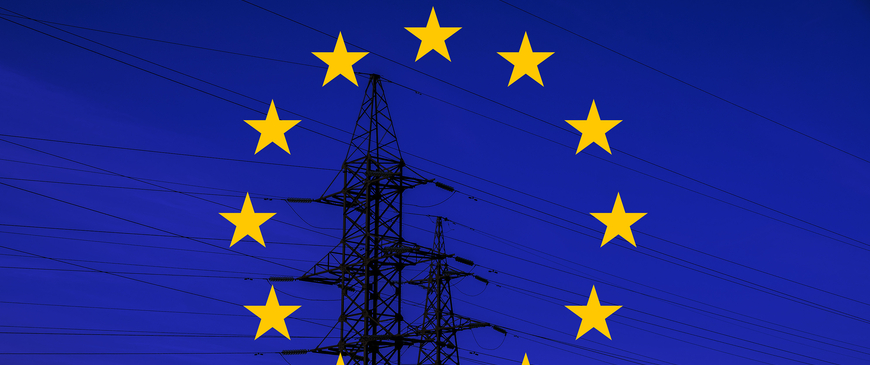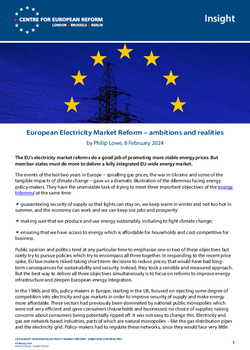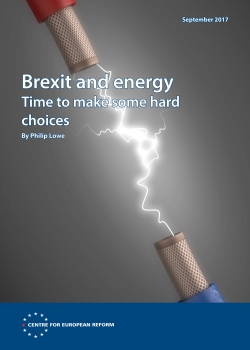
European Electricity Market Reform – ambitions and realities
The EU’s electricity market reforms do a good job of promoting more stable energy prices. But member-states must do more to deliver a fully integrated EU-wide energy market.
The events of the last two years in Europe – spiralling gas prices, the war in Ukraine and some of the tangible impacts of climate change – gave us a dramatic illustration of the dilemmas facing energy policy-makers. They have the unenviable task of trying to meet three important objectives of the ‘energy trilemma’ at the same time:
- guaranteeing security of supply so that lights can stay on, we keep warm in winter and not too hot in summer, and the economy can work and we can keep our jobs and prosperity
- making sure that we produce and use energy sustainably, including to fight climate change;
- ensuring that we have access to energy which is affordable for households and cost-competitive for business.
Public opinion and politics tend at any particular time to emphasise one or two of these objectives but rarely try to pursue policies which try to encompass all three together. In responding to the recent price spike, EU law-makers risked taking short-term decisions to reduce prices, that would have bad long-term consequences for sustainability and security. Instead, they took a sensible and measured approach. But the best way to deliver all three objectives simultaneously is to focus on reforms to improve energy infrastructure and deepen European energy integration.
In the 1980s and 90s, policy-makers in Europe, starting in the UK, focused on injecting some degree of competition into electricity and gas markets in order to improve security of supply and make energy more affordable. These sectors had previously been dominated by national public monopolies which were not very efficient and gave consumers (households and businesses) no choice of supplier, raising concerns about consumers being potentially ripped off. It was not easy to change this. Electricity and gas are network-based industries, parts of which are natural monopolies – like the gas distribution pipes and the electricity grid. Policy-makers had to regulate these networks, since they would face very little competition. They also had to separate the management of networks from more competitive parts of the market, like energy generation and retail supply. Otherwise, the monopolies would have incentives to distort competition among generators and retailers. Consequently, every country in Europe now has a national energy regulator and an independent electricity grid operator.
But most countries also realised that, even in supposedly competitive parts of the market, competition would not work immediately: many consumers would not have the time or confidence to shop around for the best energy deal. You could not deregulate energy markets without ensuring adequate protection for consumers, especially the vulnerable. So national energy regulators were given the remit not just to promote competition between retailers but also to ensure that retailers treated consumers fairly.
Yet, in the early 2000s, the political focus changed to another of the three energy policy objectives: sustainability. It was not good enough to have competitive supplies of energy. The generation and supply of energy based on fossil fuels was polluting the atmosphere with large amounts of carbon dioxide. Therefore, future energy supplies needed to be carbon-free. The technologies which could enable this were either expensive and/or controversial (nuclear) or at that point relatively untried and costly (renewables). Therefore, energy policies started to concentrate on investing in these technologies and where possible bringing their costs down.
But by the early 2020s, the policy emphasis changed again as it was not clear how to guarantee sustainable supplies of energy at affordable prices. Russia’s invasion of the Ukraine exposed the vulnerability of Europe to a cut-off in pipeline supplies of Russian gas. As gas was in short supply, its price rocketed. Furthermore, in Europe’s wholesale electricity markets, purchasers of energy pay all energy producers the same ‘clearing price’ – the price at which enough energy is produced to meet demand. The objective of having one ‘clearing price’ is to promote efficiency: energy which is cheaper to produce earns greater profits. However, the clearing price is often set by gas plants, since they can be turned on and off to meet changing demand more easily than renewables. Effectively, this means gas normally sets the price of electricity, so when gas prices rise, electricity prices increase too.
The reaction across Europe at the political level to rising gas and electricity prices was mixed. Most governments took measures to protect ordinary households and economic sectors which relied heavily on gas or electricity. Some installed price caps at the wholesale or retail level. Others said that the market was working well and that high prices gave the correct incentives to consumers to reduce their consumption and to the market to change sources of supply in the short and medium term, and these governments therefore provided support in other ways, such as through one-off payments. EU member-states eventually agreed to a cap on the wholesale price of gas but at a level – €180/MWh – which is unlikely to be reached given current developments in the global gas market. The market price has been below €100/MWh throughout 2023 and is currently less than €30/MWh.
The reaction across Europe at the political level to rising gas and electricity prices was mixed. Most governments took measures to protect ordinary households and economic sectors which relied heavily on gas or electricity.
As a result of the cap providing little support, it was not surprising that the European Commission found itself under considerable pressure at the beginning of 2023 to re-examine how EU electricity markets were working and in particular to see how the price of electricity could be disassociated from the price of gas. It adopted a proposal for Electricity Market Reform (EMR) in March.
In parallel, the UK Government launched REMA, its Review of Electricity Market Arrangements, which – given previous UK reforms such as the introduction of Contracts for Difference (CfDs), contracts between generators and governments to de-risk investment by giving generators more predictable revenues – already went further than the Commission proposals. For example, REMA included consideration of locational rather than zonal electricity pricing, which would split Great Britain into smaller areas each with their own wholesale energy prices, therefore encouraging more efficient investment. As on previous occasions, the UK may lead the way in reforming energy markets.
Following several months of public debate and formal negotiations, the three EU institutions (the Council of EU member-states, the European Parliament and the European Commission) reached a provisional agreement on a revised text on EMR on 23rd December 2023.
Despite having spent a large part of my career in the European Commission and being used to EU vocabulary and parlance, the agreed text is not a miracle of clarity. The original Commission proposal was already difficult to read for even the most intelligent expert. It proposed a Regulation to change an EU Directive (2019/944) and a Regulation (2019/943), as well as changes to the EU Renewables Directive (2018/2001), to the regulation on monitoring and transparency in energy markets (REMIT) and to the Regulation on the powers of ACER, the EU agency for the co-ordination of the action of EU national energy regulators. Several of the Regulations relating to Electricity Network Codes such as Balancing, Congestion Management and Cross-border Connections also need to be modified as a consequence of the proposals.
The result was never going to be easy to explain to the wider public. However, the agreement reached in December has many positive aspects.
The EU institutions agree that the price of electricity paid by consumers should not be determined simply by the spot or day-ahead price of electricity. On the one hand, investments in electricity generation and grids cost a lot of money and, in general, aim at meeting consumption needs over a period of 30-40 years. So investors want some degree of certainty that their investments will earn an adequate return over the long run. On the other hand, many businesses and households who consume energy need to have some idea about how much they will have to pay for electricity over longer periods than just a couple of days. The electricity market should reflect this demand for a longer-term assessment of demand and supply by facilitating competitive auctioning of contracts for electricity over periods which are longer than three to four years.
The EU institutions agree that the price of electricity paid by consumers should not be determined simply by the spot or day-ahead price of electricity.
The agreement therefore contains a series of prescriptions to promote long-term contracts for energy. These include power purchase agreements (PPAs) between users of energy (whether large industrial customers or groups of households and small businesses) and generators, and contracts for difference (CfDs) between governments and generators. The more that electricity requirements are contracted long-term, the less influence the spot price for the marginal source of electricity generation (typically gas) will have on the price which consumers pay for electricity.
The agreement also emphasises protecting vulnerable consumers and allowing individual households and small companies to aggregate their needs and negotiate collectively with suppliers. Member-states may also take exceptional measures when they collectively agree that there is a serious energy crisis.
At the same time the agreement preserves the EU’s long-term objective to create an integrated and interconnected market for energy across the EU which ultimately should contain energy prices and strengthen security of supply. Any contract for delivery of electricity should allow for supplies to flow easily across the EU’s internal national borders without any interconnection capacity restrictions. Thankfully, the member-states and the European Parliament resisted the pressure to impose price or revenue caps on existing generators, which would have harmed investor confidence in the green transition and could even have encouraged member-states to move away from market-based pricing in the European single market. From that point of view, the December agreement is a major success.
And the agreement recognises that so-called Capacity Remuneration Mechanisms can ensure security of supply by paying generators to make capacity available or by paying other market players to provide demand-side flexibility through demand response measures.
So the ambitions of the December agreement are laudable. Why, then, might we hold off on celebrating?
The first cause for some reticence is intrinsic to any instrument of EU legislation. To what extent is the agreement dependent on how individual member-states implement the changes to the directives concerned, on how effective their implementation is, and whether changes made through amendments to EU regulations have a direct legal effect on market players? Can this all be implemented easily?
Secondly, it is complex for governments and regulators to make energy markets work effectively, in particular in the EU (but not just the EU: other jurisdictions are equally complex, including the US). It is not as if the only actors are the national ministries of the member-states. EU energy market legislation assigns roles for autonomous national energy regulators (combined together in an association called CEER), as well as for ACER, the European agency responsible for the coordination of the work of the national energy regulators. It also designates a role for the European Network of the 39 Transmission System Operators (ENTSO-E), in the EU and among its neighbours, which plans and co-ordinates transmission grid development. Market transactions for electricity are run by so-called Nominated Market Operators (NEMOs, essentially power exchanges). There are Regional Co-ordination Centres (RCCs) for cross-border co-operation between European Transmission System Operators (TSOs), and implementation of European Network Codes in various regions of the EU (including the Nordics, Baltics, Central Europe and South East Europe). Finally, there are some 900 Distribution System Operators who manage the connections to electricity consumers.
Nor should we forget that the success of any new electricity market design is also dependent on the effective development and functioning of the transmission and distribution grids which deliver electricity from producers to consumers. The European Commission has said it will publish further proposals for the future of Europe’s energy grids this month. Already there are many ongoing national debates, for example in Germany, on the need for new transmission lines. And everywhere, there is the elephant in the room of permitting procedures for new energy projects: current processes can delay new projects by 10-12 years.
I do not want to be pessimistic about the prospects for implementing the reforms agreed in December. They go in the right direction. And the current reforms will certainly be complemented by further changes as the renewables play a progressively more important role in the energy mix and other technologies such as those related to hydrogen and Carbon Capture, Usage and Storage (CCUS) are applied more widely. But there is a need for realism and a sense of urgency. European countries need to show much more solidarity. Despite their hesitation, a single, integrated, interconnected energy market across Europe will do more to lower prices for consumers, more for decarbonisation and more for security of supply, than trying to do everything at national level.
A single, integrated, interconnected energy market across Europe will do more to lower prices for consumers, more for decarbonisation and more for security of supply, than trying to do everything at national level.
The agreement between the EU institutions, naively in my view, asks the Commission to carry out a review of the reforms in 2026. The text of the agreement does not yet indicate when the reforms come into force legally. But a review in 2026 will only be able to assess the experience in implementing the new legislation over a period of eighteen months at the most.
We need a wake-up call to all European governments, national agencies and regulators that this reform is urgent and there is no time left for dithering or insisting on detailed aspects of national competencies for electricity markets. If we want to create a fully functioning market for carbon-free electricity in Europe, the right time to start doing it is now.
This reform is of course not the end of the story because once our energy mix is predominantly renewable, there will be a need for further changes. Some European regions will perhaps be overwhelmed by an overcapacity of intermittent renewable power whereas others will still rely in part on gas, coal or lignite. Will market price in the future be dominated by auctions for long-term PPAs? Will the wholesale market only reflect the intraday and balancing markets? A lot of imponderables, but no reason for not putting in place the reforms which have already been agreed.
Sir Philip Lowe is a distinguished fellow at the Centre for European Reform and a former director-general for energy, European Commission.



Add new comment